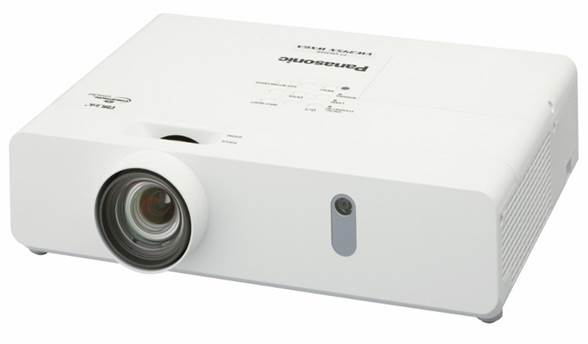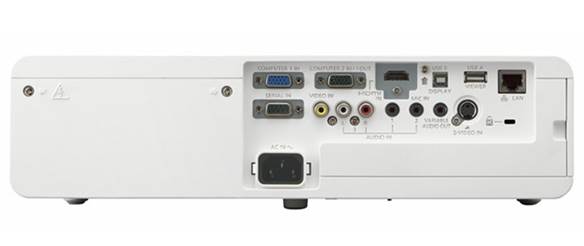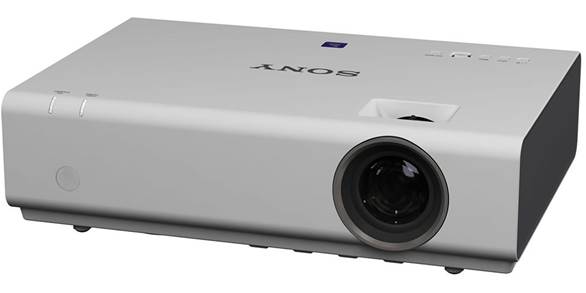Panasonic PT-VW345NZ
Features & Setup
The PT-VW345NZ is arguably the easiest projector in this
roundup to get up and running. Video source is detected automatically, so too
are horizontal/vertical keystone correction and white balance adjustments.
Instead of judging focus by eye, there’s an on-screen focusing guide that
points you in the right direction, which is incredibly helpful if you’re trying
to nail down the sharpest image for that 200-inch projection several meters
away from the screen. Needless to say, the 1.6x zoom lens allows for flexible
installation, and we welcome the extensive set of video inputs, which include
(among others) a single HDMI, and dual VGA ports.

Panasonic PT-VW345NZ
The PT-VW345NZ also stands out with its wireless features;
the crowning one being Miracast support, which lets any Miracast and Intel
WiDi-compatible device (such as recent Android phones and tablets) mirror its
screen on the big screen without going through an access point. Alternatively,
you can use the Panasonic Wireless Projector app that’s available for both
Android and iOS devices. For laptop-toting users, there are software and
(optional) hardware tools to simplify the pairing process. All these coupled
with the built-in USB memory reader make the PT-VW345NZ a cable-hating
presenter’s dream come true.
Performance
Besides a strong suite of wireless features,
performance-wise, there’s also a lot going in favor for the PT-VW345NZ. At
Normal lamp power mode and with picture mode set to Dynamic, it’s a very bright
projector at 3,700 lumens. While the Epson EB-1945W is measured to be brighter,
if judging just by the eye, you’d have thought that the PT-VW345NZ has closer
to 4,000 lumens. If you need to go brighter, there’s a PT-VX415NZ you can
consider. It’s rated at 4,200 lumens and retains the Miracast wireless
capability - the caveat is this is an XGA (1,024x768) model.

Panasonic PT-VW345NZ connectors
The PT-VW345NZ’s zooming smoothness, brightness uniformity,
and keystone correction range are also on a par with its rivals. Cost of
ownership is a recurring checkbox for any business projector buyer, and in this
regard, the PT-VW345NZ scores well too. Out of the box, the lamp lasts up to
4,000 hours; activate the Eco2 mode, and it’ll squeeze an additional 2,000
hours of run-time. Image quality for the most part is solid: color fidelity is
very good for presentations. Even when displaying video signals, colors are
richly saturated. Scaling of non-native resolutions is also well handled. All
in all, this is one highly versatile projector.
Sony VPL-EW276
Features & Setup
The Sony VPL-EW276 prides itself on its energy-saving
features. The various power-saving schemes are mostly transparent to the user.
For example, your audience most likely won’t notice that the lamp has dimmed
when you pause on a slide to explain it. For further savings (especially if
you’ve a small room), the 2,100-lumen ‘Low’ lamp mode helps extend lamp life to
as long as 7,000 hours. While you can’t slide the lens cover shut like the NEC
P451W to ‘mute’ the projection, a ‘Pic Muting’ button on the supplied remote
control serves the same purpose. The list of I/O options remains unchanged from
last year’s VPL-EW275; from VGA (two of them), HDMI, and S-Video, to RS-232C,
RJ-45, and a USB memory reader, it has all the bases covered. What’s new this
year though is support for wireless presentation from mobile devices. But for
this to work, you need to buy a USB wireless LAN dongle and install a VueMagic
mobile presenter app. There are two versions of this app, Basic and Pro, with
the latter normally priced at US$3.99 (it’s a free download at the moment), and
which offers additional features like annotation and network-based
presentations.
Performance
While the Sony VPL-EW276 also has a 1.6x zoom lens like the
Panasonic PT-VW345NZ, it’s the better choice if you’ve a small room thanks to
its 1.10:1 to 1.79:1 throw ratio, which means it can be placed slightly closer
to the screen. At its brightest settings (lamp mode set to High), the image
quality is brilliant. Initially, we were worried that the auto brightness
feature (somewhat like an automatic iris) would result in sudden and jarring
brightness jumps, but we hardly noticed that during our tests.

Sony VPL-EW276
The only thing we observed was the slightly more audible
purr when we projected a mostly white image, which ramped up the brightness.
Color accuracy was a tad off at such high light output, but reduced greatly
after we spent a couple of minutes fiddling with the color adjustments. A
Presentation mode appears when a VGA input is used, and provides more well-balanced
colors without sacrificing too much brightness. The Cinema picture mode is our
favorite for movie and video content, as it offers a neutral tone, not to
mention darker blacks and less murky shadow details. Overall, the VPL-EW276
hardly puts a foot wrong, whether data or movie performance.
Specifications
·
Model: Panasonic PT-VW345NZ
·
Technology: 3LCD
·
Native Resolution: 1,280x800 (WXGA)
·
Lens Zoom: 1.6x
·
Throw Ratio: 1.2 to 1.9
·
Brightness (MAX/ECO): 3,700lm
·
Contrast Ratio: 3,000:1
·
Keystone Correction: ±40°/±30° (V/H)
·
Input – Video: HDMI, 2x analog RGB, S-Video, composite
·
Input – Audio: Stereo mini, mic-in, L-R RCA
·
Output – Video: Monitor out
·
Output – Audio: Stereo mini
·
Control & Network: RS-232C, RJ45, Wi-Fi
·
USB: Type A and B
·
Speaker: 10W
·
Noise Level ( MAX/ECO): 35/29dB
·
Power Consumption (MAX/ECO): 280W
·
Lamp Life (STD/ECO): 4,000/6,000 hours
·
Dimensions: 352x279.4x98mm
·
Weight: 3.4kg
·
Price: $2,099
|